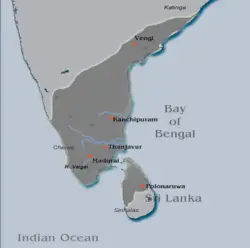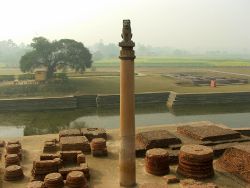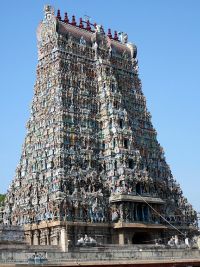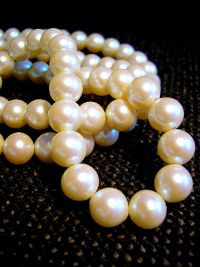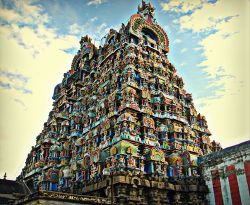Pandyan Kingdom
The Pandyan kingdom was an ancient Tamil state in South India of unknown antiquity. Pandyas were one of the three ancient Tamil kingdoms (Chola and Chera being the other two) that ruled the Tamil country from pre-historic times until end of the fifteenth century. They ruled initially from Korkai, a seaport on the southern-most tip of the Indian peninsula, and in later times moved to Madurai. Pandyas entered their golden age under Jatavarman Sundara Pandyan (c. 1251) who expanded their empire into Telugu country and invaded Sri Lanka to conquer the northern half of the island. Their territory included present-day Kerela. They also had extensive trade links with the Southeast Asian maritime empires of Srivijaya and their successors. The Pandyas excelled in both trade and literature. They controlled the pearl fisheries along the South Indian coast, between Sri Lanka and India, which produced some of the finest pearls known in the ancient world. Tradition holds that the legendary Sangam were held in Madurai under their patronage. Some of the Sangam poets became kings of Pandya.
The early Pandyan dynasty went into obscurity during the invasion of the Kalabhras. The dynasty revived under Kadungon in the early sixth century. They pushed the Kalabhras out of the Tamil country and ruled from Madurai. They again went into decline with the rise of the Cholas in the ninth century and were in constant conflict with them. Pandyas allied themselves with the Sinhalese and the Cheras in harassing the Chola empire until they found an opportunity for reviving their fortunes during the late thirteenth century. During their history the Pandyas were repeatedly in conflict with the Pallavas, the Cholas, the Hoysalas, and finally the Muslim invaders from the Delhi Sultanate. Nonetheless, they also gave peace and stability to the southern plains of India for many centuries. In the end, they could not compete with the Muslim Delhi Sultanate as it pushed south, and lost power in the sixteenth century. Within a century, the British East India Company had started its operations and by the end of the eighteenth century this part of India was part of British India.
Sources
Sangam literature
Pandyas are mentioned in Sangam literature (c. 100 – 200 C.E.) as well as by Greek and Roman sources during this period. Various Pandyan kings are mentioned in a number of poems in the Sangam literature. Among them, Nedunjeliyan ("the victor of Talaiyalanganam"), Nedunjeliyan ("the conqueror of the Aryan army"), and Mudukudimi Peruvaludi ("of several sacrifices") deserve special mention. Besides several short poems found in the Akananuru and the Purananuru collections, there are two major works, Mathuraikkanci and the Netunalvatai (in the collection of Pattupattu), that give a glimpse into the society and commercial activities in the Pandyan kingdom during the Sangam age.
It is difficult to estimate the exact date of these Sangam-age Pandyas. The period covered by the extant literature of the Sangam is unfortunately not easy to determine with any measure of certainty. With the exception of the longer epics Cilappatikaram and Manimekalai, which by common consent belong to the age later than the Sangam age, the poems have reached us in the forms of systematic anthologies. Each individual poem generally has attached to it a colophon on the authorship and subject matter of the poem, the name of the king or chieftain to whom the poem relates, and the occasion that called forth the eulogy.
It is from these colophons and rarely from the texts of the poems themselves, that we gather the names of many kings and chieftains and the poets and poetesses patronized by them. The task of reducing these names to an ordered scheme in which the different generations of contemporaries can be marked off has not been easy. To add to the confusion, some historians have even denounced these colophons as later additions and untrustworthy as historical documents.
Any attempt at extracting a systematic chronology and data from these poems should take into account their casual nature and the wide difference between the purpose of the anthologist who collected them and the purpose of the historian trying to construct a continuous history.
Epigraphy
The earliest Pandyan to be found in epigraph is Nedunjeliyan, who figures in the Minakshipuram record assigned from the second to the first centuries B.C.E. The record documents a gift of rock-cut beds to a Jain ascetic. Punch-marked coins in the Pandyan country dating from around the same time have also been found.
Pandyas are also mentioned in the Pillars of Ashoka (inscribed 273 – 232 B.C.E.). Asoka in his inscriptions refers to the peoples of South India, the Cholas, Cheras, Pandyas, and Satiyaputras, as recipients of his Buddhist proselitism. These kingdoms, although not part of the Mauryan Empire, were on friendly terms with Asoka:
- The conquest by Dharma has been won here, on the borders, and even six hundred yojanas (5,400 – 9,600 km) away, where the Greek king Antiochos rules, beyond there where the four kings named Ptolemy, Antigonos, Magas and Alexander rule, likewise in the south among the Cholas, the Pandyas, and as far as Tamraparni (Sri Lanka). (Edicts of Ashoka, 13th Rock Edict, S. Dhammika)
Foreign sources
The Periplus of the Erythraean Sea (c. 60 – 100 C.E.) describes the riches of a "Pandian Kingdom":
- …Nelcynda is distant from Muziris by river and sea about five hundred stadia, and is of another Kingdom, the Pandian. This place also is situated on a river, about one hundred and twenty stadia from the sea.…
The Chinese biographer Yu Huan in his text Weilüe mentions the Kingdom of Panyue: "…The kingdom of Panyue is also called Hanyuewang. It is several thousand li to the southeast of Tianzhu (Northern India)…. The inhabitants are small; they are the same height as the Chinese…" (Hill 2004).
The Roman emperor Julian received an emissary from Pandya about 361. A Roman trading center was located on the Pandyan coast (Alagankulam, at the mouth of the Vaigai River, southeast of Madurai).
Pandyas also had trade contacts with Ptolemaic Egypt and, through Egypt, with Rome by the first century, and with China by the third century. The first-century Greek historian Nicolaus of Damascus met, at Damascus, the ambassador sent by an Indian king "named Pandion or, according to others, Porus" to Caesar Augustus around 13 C.E. Marco Polo visited Madurai in 1295. Ibn Battuta visited in 1333 C.E. There was significant sea trade between the Pandyan kingdom and the ancient Mediterranean world, as well as China. Texts even refer to the Pandyan kings having Roman guards.
List of Pandyan kings
Although there are many instances of the Pandyan kingdom being referred in ancient literature and texts, there is no way to determine a cogent genealogy of these ancient kings. The names of the earliest rulers cannot be confirmed but historians have constructed a chronological history of the Pandyas from the fall of Kalabhras during the middle of the sixth century.
The following lists of the Pandyan kings are based on the work of Sasti (1998).
First empire
After the close of the Sangam age, the first Pandyan empire was established by Kadungon defeating the Kalabhras in the sixth century. The following is a chronological list of the Pandyan emperors based on an inscription found on the Vaigai riverbeds.
- Kadungon (560 – 590)
- Maravarman Avani Culamani (590 – 620)
- Cezhiyan Cendan (620 – 640)
- Arikesari Maravarman Nindraseer Nedumaaran (640 – 674)
- Kochadaiyan Ranadhiran (675 – 730)
- Arikesari Parankusa Maravarman Rajasinga (730 – 765)
- Parantaka Nedunjadaiyan (765 – 790)
- Rasasingan II (790 – 800)
- Varagunan I (800 – 830)
- Sirmara Srivallabha (830 – 862)
- Varaguna II (862 – 880)
- Parantaka Viranarayana (862 – 905)
- Rajasimha III (905 – 920)
After the defeat of the Kalabhras, the Pandyan kingdom grew stronger and stronger and witnessed a steady increase in its power and territory. With the Cholas in obscurity, the Tamil country was divided between the Pallavas and the Pandyas, the river Kaveri being the frontier between them.
After Vijayalaya Chola conquered Thanjavur, defeating the Muttarayar chieftains around 850, the Pandyas went into a period of decline. They were constantly harassing the Chola overlords occupying their territories. Parantaka Chola I invaded the Pandyan territories and defeated Rajasinha II. However, Pandyas reversed this defeat to gain back most of their lost territories.
Under the Cholas
The Chola domination of the Tamil country began in earnest during the reign of Parantaka Chola II. Cholan armies led by Aditya Karikala, son of Parantaka Chola II, defeated Vira Pandya in battle. The Pandyas were assisted by the Sinhalese forces of Mahinda IV. The Pandyas were driven out of their territories and had to seek refuge on the island of Sri Lanka. This was the start of the long exile of the Pandyas. They were replaced by a series of Chola viceroys with the title Chola Pandyas who ruled from Madurai from c. 1020.
The following list gives the names of the Pandyan kings who were active during the tenth and the first half of eleventh century. It is difficult to give their date of accession and duration of their rule.
- Sundara Pandya I
- Vira Pandya I
- Vira Pandya II
- Amarabhujanga Tivrakopa
- Jatavarman Sundara Chola Pandya
- Maravarman Vikrama Chola Pandya
- Maravarman Parakrama Chola Pandya
- Jatavarman Chola Pandya
- Srivallabha Manakulachala (1101 – 1124)
- Maaravaramban Seervallaban (1132 – 1161)
- Parakrama Pandyan (1161 – 1162)
- Kulasekara Pandyan III
- Vira Pandyan III
- Jatavarman Srivallaban (1175 – 1180)
- Jatavarman Kulasekara Devan (1180 – 1216)
Pandyan revival
The thirteenth century was the greatest period in the history of the Pandyan Empire. Their power reached its zenith under Jatavarman Sundara Pandyan in the middle of the thirteenth century. The foundation for such a great empire was laid by Maravarman Sundara Pandya early in the thirteenth century.
- Maravarman Sundara Pandya (1216 – 1238)
- Sundaravaramban Kulasekaran II (1238 – 1240)
- Maaravaramban Sundara Pandyan II (1241 – 1251)
- Jatavarman Sundara Pandyan (1251 – 1268)
- Maaravaramban Kulasekara Pandyan I (1268 – 1311)
- Sundara Pandyan IV (1309 – 1327)
- Vira Pandyan IV (1309 – 1345)
End of the Pandyans
After being overshadowed by the Pallavas and Cholas for centuries, Pandyan glory was briefly revived by the much celebrated Jatavarman Sundara Pandyan in 1251 and the Pandyan power extended from the Telugu countries on banks of the Godavari River to the northern half of Sri Lanka. On the death of Maaravaramban Kulasekara Pandyan I in 1308, a conflict stemming from succession disputes arose amongst his sons. Sundara Pandya and Vira Pandya fought each other for the throne. Soon Madurai fell into the hands of the invading armies of the Delhi Sultanate. Pandyas and their descendants were confined to a small region around Thirunelveli for a few more years and after the seventeenth century C.E. no more is heard of them. After Madurai fell into the hands of the invading armies of the Delhi Sultanate, the Pandyas sought the help of the Vijayanagar Empire. The Vijayanagar Empire replaced the Delhi Sultanate in Madurai and appointed Nayaks governers to rule from Madurai. There are many historic reasons for the closer relations with the Pandyan kingdom of Madurai and the Paravas community. The Paravas were the chiefs of the coastal region and they ruled their areas as subordinates of the Pandyas of the Sangam age.[1]
The Paravas' headquarters was located at Korkai Harbor during the regime of the Pandyan kingdom and they all spread out into 22 fishing hamlets, namely Rajackal Mangalam, Kovalam, Kanyakumari, Kumari muttam, Kootapuli, Perumanal, Idinthakarai, Kuthenkuly, Uvari, Periathalai, Pudukarai, Manapad, Alanthalai, Thiruchendur, Virapandianpatnam, Thalambuli, Punnaikayal, Palayakayal, Tuticorin, Vaippar, Chethupar, Vembar, and Mookur in the pearl fishery coast of the Gulf of Mannar and the adjacent Comerin coast. Tuticorin, the port city of the Pandyan kingdom, has always been a stronghold of the Paravas. They had a succession of kings among them, distinguished by the title Adiarasen. Some of these chiefs seem to have resided at Uttara Kosmangay near Ramnad. The story of this city itself is clear evidence to this fact. Later, the leaders were called by the following names: Thalaivan, Pattankattiyars, and Adappannars. Kumarimuttom can be considered as the western boundary for the community as the people are also inhabitants of Muttom and Pillaithoppu.
Culture
Religion
Historical Madurai was a stronghold of Shaivism. Following the invasion of Kalabhras, Jainism gained a foothold in the Pandyan kingdom. With the advent of Bhakti movements, Saivism and Vaishnavism resurfaced. The latter-day Pandyas after 600 C.E. were Saivites who claimed to descend from Lord Shiva and Goddess Parvati. Pandyan Nedumchadayan was a staunch Vaishnavite.[2]
Trade
Roman and Greek traders frequented the ancient Tamil country, present day Southern India and Sri Lanka, securing trade with the seafaring Tamil states of the Pandyan, Chola and Chera dynasties and establishing trading settlements which secured trade with South Asia by the Greco-Roman world since the time of the Ptolemaic dynasty[3] a few decades before the start of the Common Era and remained long after the fall of the Western Roman Empire.[4] As recorded by Strabo, Emperor Augustus of Rome received at Antioch an ambassador from a South Indian King called Pandyan. They also outlasted Byzantium's loss of the ports of Egypt and the Red Sea[5] (c. 639-645) under the pressure of the Muslim conquests. Sometime after the sundering of communications between the Axum and Eastern Roman Empire in the seventh century, the Christian kingdom of Axum fell into a slow decline, fading into obscurity in western sources. It survived, despite pressure from Islamic forces, until the eleventh century, when it was reconfigured in a dynastic squabble.
Pearl fishing
Pearl fishing was another industry that flourished during the Sangam age. The Pandyan port city of Korkai was the center of pearl trade. Written records from Greek and Egyptian voyagers give details about the pearl fisheries off the Pandyan coast. The Periplus of the Erythraean Sea mentions that "Pearls inferior to the Indian sort are exported in great quantity from the marts of Apologas and Omana".[6] The inferior variety of pearls that the Tamils did not require for their use was in very great demand in the foreign markets.
The pearls from the Pandyan kingdom were also in demand in the kingdoms of north India. Several Vedic mantras refer to the wide use of the pearls. The royal chariots were decked with pearls, as were the horses that dragged them. The use of pearls was so high that the supply of pearls from the Ganges could not meet the demand.[7]
Architecture
Rock cut and structural temples are significant part of pandyan architecture. Vimana, mandapa and shikhara are some of the features of the early Pandyan temples. Groups of small temples are seen at Tiruchirapalli district of Tamil Nadu. The Shiva temples have a Nandi in front of the maha mandapa. In the later stages of Pandyas rule, finely sculptured idols, portals of temples or gopurams on "Vimanas" were developed. Gopurams are the rectangular entrance and portals of the temples. The portions above the entrance is pyramidal in shape. Gradually gopurams were given more importance than Shikharas.
Meenakshi Temple in Madurai and Nellaiappar Temple in Tirunelveli were built during the reign of the Pandyas.
Legacy
While the Pandyans fought local rivals to maintain their kingdom and did at times extend their territory, they do not appear to have had imperial ambitions as such and did not compete with the larger imperial dynasties in India. Eventually, however, they could not withstand the imperial ambitions of the Delhi Sultanate. Although they had long enjoyed trade with the wider world, and were by no means isolated from global interests, they had maintained political independence. However, in a world of expanding empires—initially the Muslim drive south from their stronghold in Delhi in the north followed by the British and other Europeans, especially the French with whom they competed—the Pandyan kingdom could not survive. The Muslim conquest was followed by incorporation within the Vijayanagar Empire, then into the British Empire, and eventually by the emergence of India as an independent state in 1947. The ancient kingdom of the Pandyans is now largely within the state of Tamil Nadu.
Notes
- ↑ "Aritapatti Inscription Throws Light on Jainism,” The Hindu, September 15, 2003. Aritapatti Inscription Throws Light on Jainism. Retrieved November 7, 2007.
- ↑ Lloyd Ridgeon (ed.), Major World Religions: From Their Origins to the Present (Routledge, 2003, ISBN 978-0415297967).
- ↑ W. S. Lindsay, History of Merchant Shipping and Ancient Commerce (Adamant Media Corporation, 2001, ISBN 978-0543942531).
- ↑ Philip D. Curtin, Cross-Cultural Trade in World History (Cambridge University Press, 1984, ISBN 978-0521269315).
- ↑ Augustin Holl, Ethnoarchaeology of Shuwa-Arab Settlements (Lexington Books, 2003, ISBN 978-0739104071).
- ↑ T. K. Venkata Subramanian, Environment and Urbanisation in early Tamilakam (Tamil University, 1988, ISBN 978-8170901105).
- ↑ P. T. Srinivasa Iyengar, History of the Tamils (Asian Educational Services, 1995, ISBN 978-8120601451).
ReferencesISBN links support NWE through referral fees
- Curtin, Philip D. Cross-Cultural Trade in World History. Cambridge University Press, 1984. ISBN 978-0521269315
- Hill, John E. "The Peoples of the West from the Weilüe." Draft annotated English translation of A Third-Century Chinese Account Composed between 239 and 265 C.E., by Yu Huan, 2004. The Peoples of the West. Retrieved November 7, 2007.
- Holl, Augustin. Ethnoarchaeology of Shuwa-Arab Settlements. Lexington Books, 2003. ISBN 978-0739104071
- Iyengar, P. T. Srinivasa. History of the Tamils. Asian Educational Services, 1995. ISBN 978-8120601451
- Lindsay, W. S. History of Merchant Shipping and Ancient Commerce. Adamant Media Corporation, 2001. ISBN 978-0543942531
- Ray, Himanshu Prabha and Jean-Francois Salles (eds). Tradition and Archaeology: Early Maritime Contacts in the Indian Ocean. Proceedings of the International Seminar Techno-Archaeological Perspectives of Seafaring in the Indian Ocean 4th cent. B.C. – 15th cent. A.D., New Delhi, February 28 – March 4, 1994. New Delhi: Manohar Publishers and Distributors, 1998. ISBN 9788173041457
- Reddy, P. Krishna Mohan. "Maritime Trade of Early South India: New Archaeological Evidences from Motupalli, Andhra Pradesh." East and West 51 (1–2) (2001): 143–156.
- Ridgeon, Lloyd (ed.). Major World Religions: From Their Origins to the Present. Routledge, 2003. ISBN 978-0415297967
- Shastri, K. A. N. A History of South India from the Early Times to the Fall of Vijayanagar. New Delhi: Oxford University Press, 1998. ISBN 0195606868
- Shaffer, Lynda Norene. Maritime Southeast Asia to 1500. Armonk, NY: M. E. Sharpe, Inc., 1996. ISBN 9781563241437
- Venkata Subramanian, T. K. Environment and Urbanisation in early Tamilakam. Tamil University, 1988. ISBN 978-8170901105
External links
All links retrieved January 12, 2019.
- Inscriptions of India – Complete listing of historical inscriptions from Indian temples and monuments.
- Pandyan Kingdom in Glorious India.
Credits
New World Encyclopedia writers and editors rewrote and completed the Wikipedia article in accordance with New World Encyclopedia standards. This article abides by terms of the Creative Commons CC-by-sa 3.0 License (CC-by-sa), which may be used and disseminated with proper attribution. Credit is due under the terms of this license that can reference both the New World Encyclopedia contributors and the selfless volunteer contributors of the Wikimedia Foundation. To cite this article click here for a list of acceptable citing formats.The history of earlier contributions by wikipedians is accessible to researchers here:
The history of this article since it was imported to New World Encyclopedia:
Note: Some restrictions may apply to use of individual images which are separately licensed.
